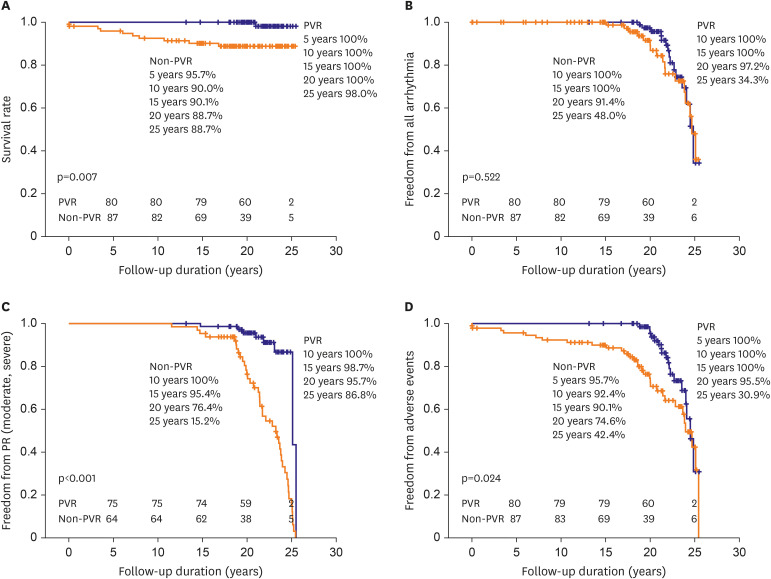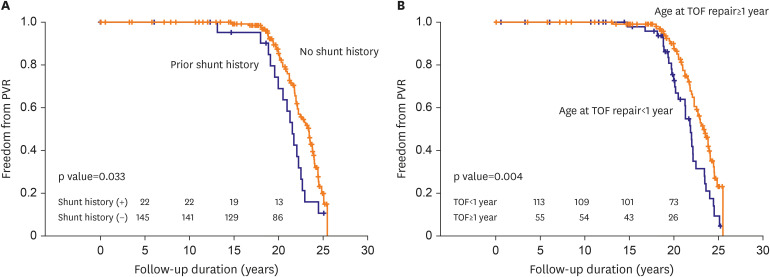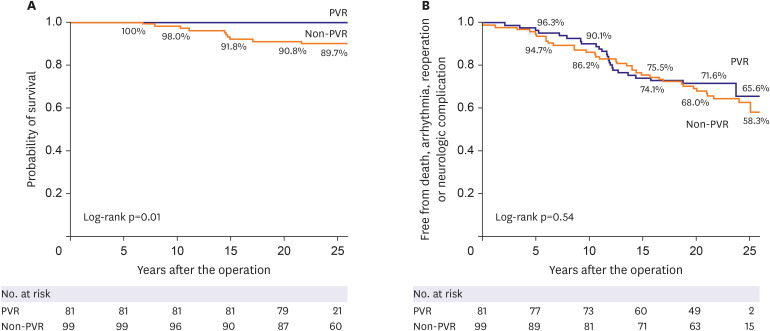Korean Circ J.
2021 Apr;51(4):360-372. 10.4070/kcj.2020.0331.
Effect of Pulmonary Valve Replacement in the Repaired Tetralogy of Fallot Patients with Trans-annular Incision: More than 20 Years of Follow-up
- Affiliations
-
- 1Department of Thoracic and Cardiovascular Surgery, Seoul National University Children's Hospital, Seoul National University College of Medicine, Seoul, Korea
- 2Department of Thoracic and Cardiovascular Surgery, Korea University Ansan Hospital, Korea University College of Medicine, Ansan, Korea
- 3Department of Thoracic and Cardiovascular Surgery, Sejong General Hospital, Bucheon, Korea
- 4Division of Cardiology, Department of Pediatrics, Seoul National University Children's Hospital, Seoul National University College of Medicine, Seoul, Korea
- KMID: 2514641
- DOI: http://doi.org/10.4070/kcj.2020.0331
Abstract
- Background and Objectives
We reviewed the long-term outcomes after tetralogy of Fallot (TOF) repair with trans-annular incision; and evaluated the effectiveness of pulmonary valve replacement (PVR) on outcomes.
Methods
This was a retrospective review of clinical outcomes of 180 of 196 TOF patients who underwent total correction with trans-annular incision from 1991 to 1997 (PVR group: 81; non-PVR group: 99).
Results
The median age of the patients was 14.0 months (interquartile range [IQR], 10.7–19.8 months) at TOF repair. Ten in-hospital deaths (5.1%) occurred. During the followup, 81 patients underwent PVR at the median age of 13.5 years (IQR, 11.2–17.1 years). The patients in PVR group showed better outcomes than non-PVR group in overall survival rate (100% in PVR vs. 88.7% in non-PVR, p=0.007), in all adverse events (arrhythmia, neurologic complications, 95.5% in PVR vs. 74.6% in non-PVR, p=0.024) at 20 years. Age at TOF repair younger than 1 year (hazard ratio [HR], 2.265; p=0.01) and previous shunt history (HR, 2.195; p=0.008) were predictive for requiring PVR. During follow-up, 10 late deaths (5 sudden deaths) occurred in the non-PVR group, mainly due to ventricular arrhythmia and right ventricular failure; there was 1 late death (not a sudden death) in the PVR group.
Conclusions
Long-term survival after repair of TOF with trans-annular incision were acceptable. However, arrhythmias were frequently observed during 20 years of follow-up. The patient age <1 year at the time of TOF repair and shunt implantation prior to TOF repair were predictive factors for requiring PVR.
Figure
Reference
-
1. Lillehei CW, Varco RL, Cohen M, et al. The first open heart corrections of tetralogy of Fallot. A 26–31 year follow-up of 106 patients. Ann Surg. 1986; 204:490–502. PMID: 3767482.2. Murphy JG, Gersh BJ, Mair DD, et al. Long-term outcome in patients undergoing surgical repair of tetralogy of Fallot. N Engl J Med. 1993; 329:593–599. PMID: 7688102.3. Therrien J, Marx GR, Gatzoulis MA. Late problems in tetralogy of Fallot--recognition, management, and prevention. Cardiol Clin. 2002; 20:395–404. PMID: 12371008.4. Gatzoulis MA, Balaji S, Webber SA, et al. Risk factors for arrhythmia and sudden cardiac death late after repair of tetralogy of Fallot: a multicentre study. Lancet. 2000; 356:975–981. PMID: 11041398.5. Geva T, Sandweiss BM, Gauvreau K, Lock JE, Powell AJ. Factors associated with impaired clinical status in long-term survivors of tetralogy of Fallot repair evaluated by magnetic resonance imaging. J Am Coll Cardiol. 2004; 43:1068–1074. PMID: 15028368.6. Bouzas B, Kilner PJ, Gatzoulis MA. Pulmonary regurgitation: not a benign lesion. Eur Heart J. 2005; 26:433–439. PMID: 15640261.7. Cheung EW, Wong WH, Cheung YF. Meta-analysis of pulmonary valve replacement after operative repair of tetralogy of Fallot. Am J Cardiol. 2010; 106:552–557. PMID: 20691315.8. Geva T, Gauvreau K, Powell AJ, et al. Randomized trial of pulmonary valve replacement with and without right ventricular remodeling surgery. Circulation. 2010; 122:S201–8. PMID: 20837914.9. Frigiola A, Tsang V, Bull C, et al. Biventricular response after pulmonary valve replacement for right ventricular outflow tract dysfunction: is age a predictor of outcome? Circulation. 2008; 118:S182–90. PMID: 18824753.10. Oosterhof T, van Straten A, Vliegen HW, et al. Preoperative thresholds for pulmonary valve replacement in patients with corrected tetralogy of Fallot using cardiovascular magnetic resonance. Circulation. 2007; 116:545–551. PMID: 17620511.11. Gengsakul A, Harris L, Bradley TJ, et al. The impact of pulmonary valve replacement after tetralogy of Fallot repair: a matched comparison. Eur J Cardiothorac Surg. 2007; 32:462–468. PMID: 17627832.12. Harrild DM, Berul CI, Cecchin F, et al. Pulmonary valve replacement in tetralogy of Fallot: impact on survival and ventricular tachycardia. Circulation. 2009; 119:445–451. PMID: 19139389.13. Park CS, Lee JR, Lim HG, Kim WH, Kim YJ. The long-term result of total repair for tetralogy of Fallot. Eur J Cardiothorac Surg. 2010; 38:311–317. PMID: 20346688.14. Kirklin JW, Blackstone EH, Pacifico AD, Brown RN, Bargeron LM Jr. Routine primary repair vs two-stage repair of tetralogy of Fallot. Circulation. 1979; 60:373–386. PMID: 445756.15. Kirklin JK, Kirklin JW, Blackstone EH, Milano A, Pacifico AD. Effect of transannular patching on outcome after repair of tetralogy of Fallot. Ann Thorac Surg. 1989; 48:783–791. PMID: 2596914.16. Voges I, Fischer G, Scheewe J, et al. Restrictive enlargement of the pulmonary annulus at surgical repair of tetralogy of Fallot: 10-year experience with a uniform surgical strategy. Eur J Cardiothorac Surg. 2008; 34:1041–1045. PMID: 18760931.17. Boni L, García E, Galletti L, et al. Current strategies in tetralogy of Fallot repair: pulmonary valve sparing and evolution of right ventricle/left ventricle pressures ratio. Eur J Cardiothorac Surg. 2009; 35:885–889. PMID: 19278860.18. Kwak JG, Kim WH, Kim ER, Lim JH, Min J. One-year follow-up after tetralogy of Fallot total repair preserving pulmonary valve and avoiding right ventriculotomy. Circ J. 2018; 82:3064–3068. PMID: 30298850.19. Oechslin EN, Harrison DA, Harris L, et al. Reoperation in adults with repair of tetralogy of Fallot: indications and outcomes. J Thorac Cardiovasc Surg. 1999; 118:245–251. PMID: 10424997.20. Knott-Craig CJ, Elkins RC, Lane MM, Holz J, McCue C, Ward KE. A 26-year experience with surgical management of tetralogy of Fallot: risk analysis for mortality or late reintervention. Ann Thorac Surg. 1998; 66:506–511. PMID: 9725393.21. Kogon B, Plattner C, Kirshbom P, et al. Risk factors for early pulmonary valve replacement after valve disruption in congenital pulmonary stenosis and tetralogy of Fallot. J Thorac Cardiovasc Surg. 2009; 138:103–108. PMID: 19577064.22. Hoashi T, Kagisaki K, Meng Y, et al. Long-term outcomes after definitive repair for tetralogy of Fallot with preservation of the pulmonary valve annulus. J Thorac Cardiovasc Surg. 2014; 148:802–808. PMID: 24993623.23. Dave HH, Buechel ER, Dodge-Khatami A, et al. Early insertion of a pulmonary valve for chronic regurgitation helps restoration of ventricular dimensions. Ann Thorac Surg. 2005; 80:1615–1620. PMID: 16242426.24. Geva T. Repaired tetralogy of Fallot: the roles of cardiovascular magnetic resonance in evaluating pathophysiology and for pulmonary valve replacement decision support. J Cardiovasc Magn Reson. 2011; 13:9. PMID: 21251297.
- Full Text Links
- Actions
-
Cited
- CITED
-
- Close
- Share
- Similar articles
-
- Pulmonary Valve Replacement after Repair of Tetralogy of Fallot
- Aortic Root and Ascending Aortic Aneurysm in an Adult with a Repaired Tetralogy of Fallot
- Pulmonary Insufficiency after Repair of Tetralogy of Fallot: Prevention and Indications of Pulmonary Valve Replacement
- A Rare Case of Tetralogy of Fallot Associated with Pulmonary Artery Sling
- A Case of Severe Pulmonary Regurgitation Due to the Absence of Pulmonary Valve




